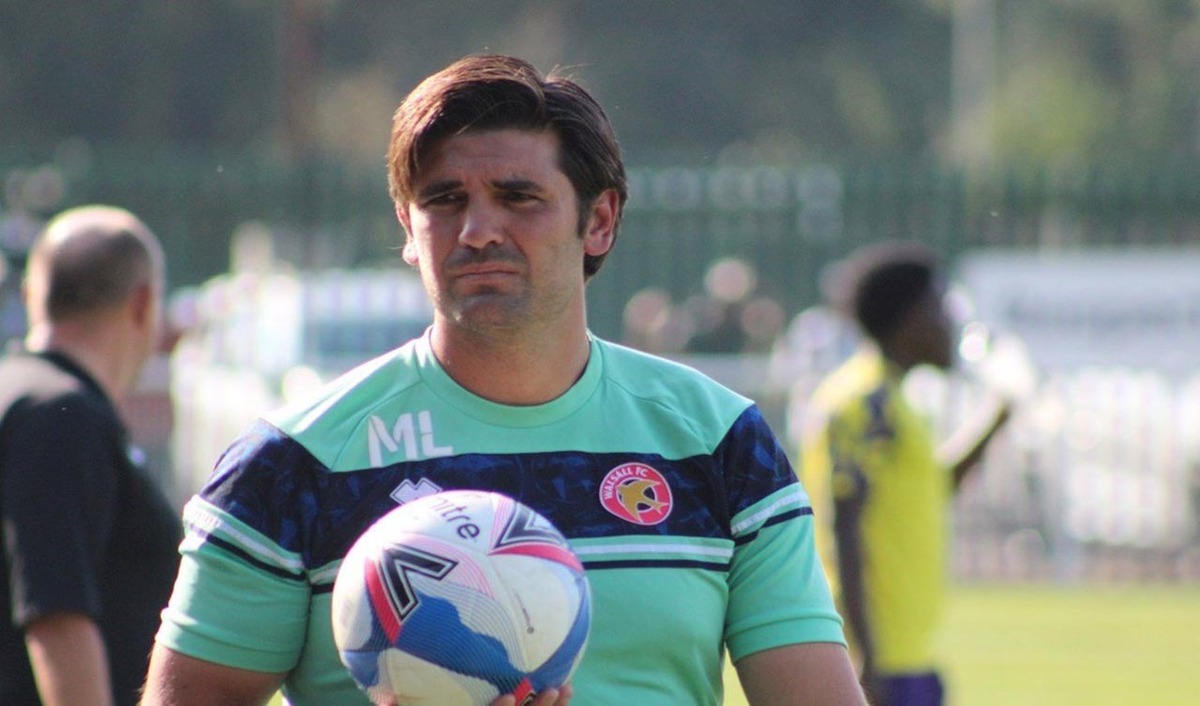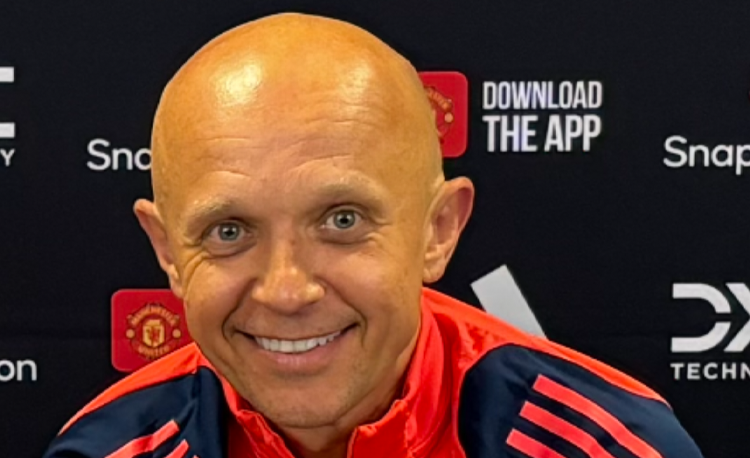You are viewing 1 of your 1 free articles
Attacking and defending transitions
| Area | Up to three quarters of pitch |
| Equipment | Balls, bibs, cones, 2 goals |
| No. of Players | Up to 20 players + 2 goalkeepers |
| Session Time | Passing exercises: 15mins 2v1 finishing waves: 9mins 3v2 finishing waves: 9mins 4v3 finishing waves: 9mins 4v3 rapid attacks: 12mins |
This session is focused on attacking and defending transitions. Transitions are one of the crucial moments in the game and the best teams have to be capable of managing the offensive and defensive transitions with confidence and speed.
This training ground practice is easy to deliver and it will help players to understand the importance of efficient transitions and how vital they are to a successful team performance.
I would run this kind of session once a week until the players understand the principles well enough. After that, running sessions like this once every two weeks could be fine as a reminder. I don’t like to repeat the sessions and I would keep working on transitions but using slighter different drills.
“This practice is easy to deliver and it will help players to understand the importance of efficient transitions”
PASSING EXERCISES
We set up in a playing area of 20x30 yards for a series of passing exercises, with four cones positioned as shown in each exercise. We’re using six outfield players, starting on the cones as shown.
In the first exercise, as shown [1a], the red player passes to the green on the central cone who plays a one-two with the blue and then carries the ball and passes to the yellow. The yellow player then passes to the white on the other side of the area, who plays the ball into the player on the central cone and the passing sequence begins again. After each action, the players follow their pass to the next station.
In the second exercise, as shown [1b], the red starts by playing a one-two with the green player and then passes out to the blue.
[1a]
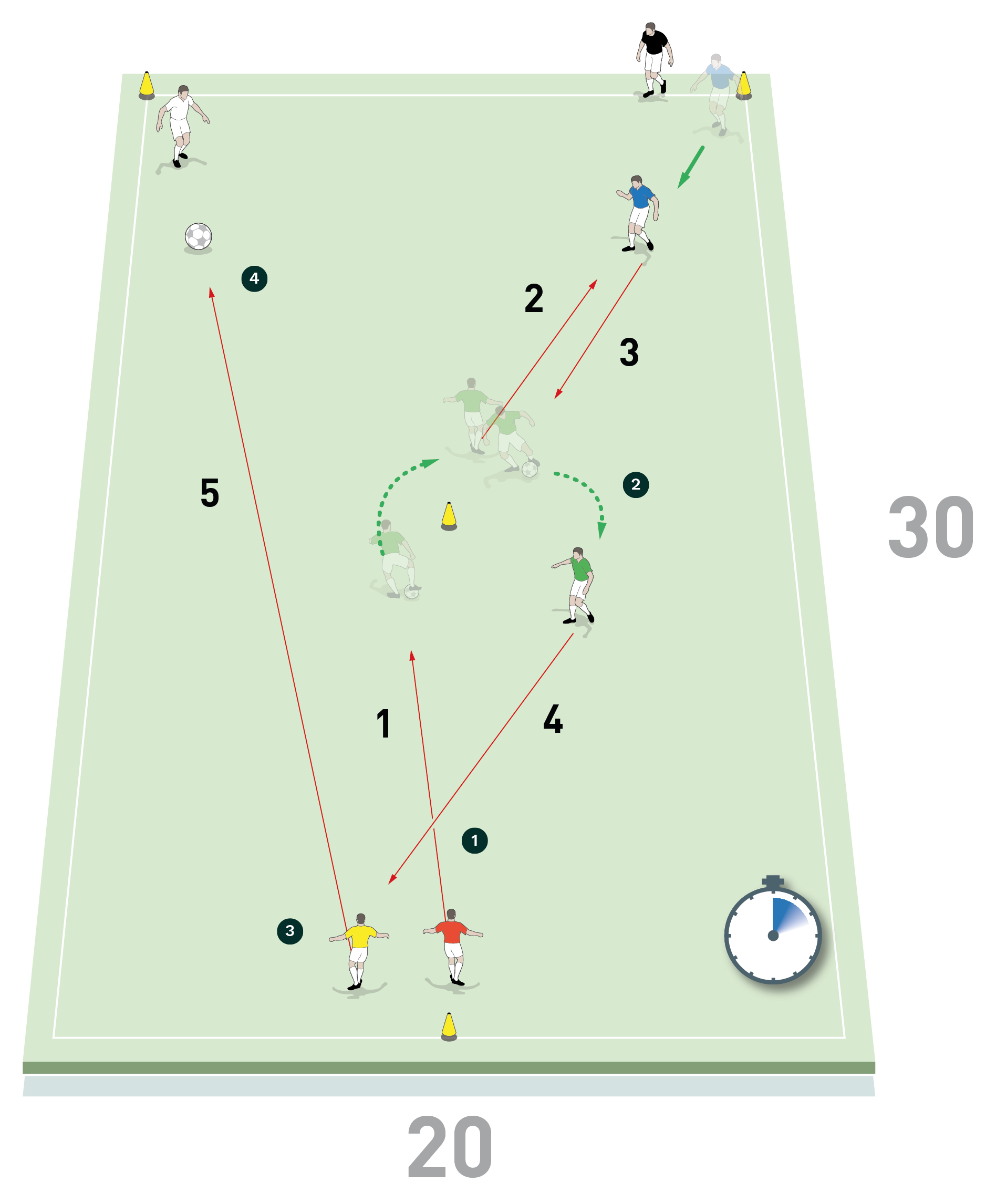
2. The green receives on the move and plays a one-two with the blue and then carries the ball and passes to the yellow
3. The yellow player passes to the white on the other side of the area to end the sequence
4. The white will play the next ball into the player on the central cone and the passing sequence begins again
[1b]
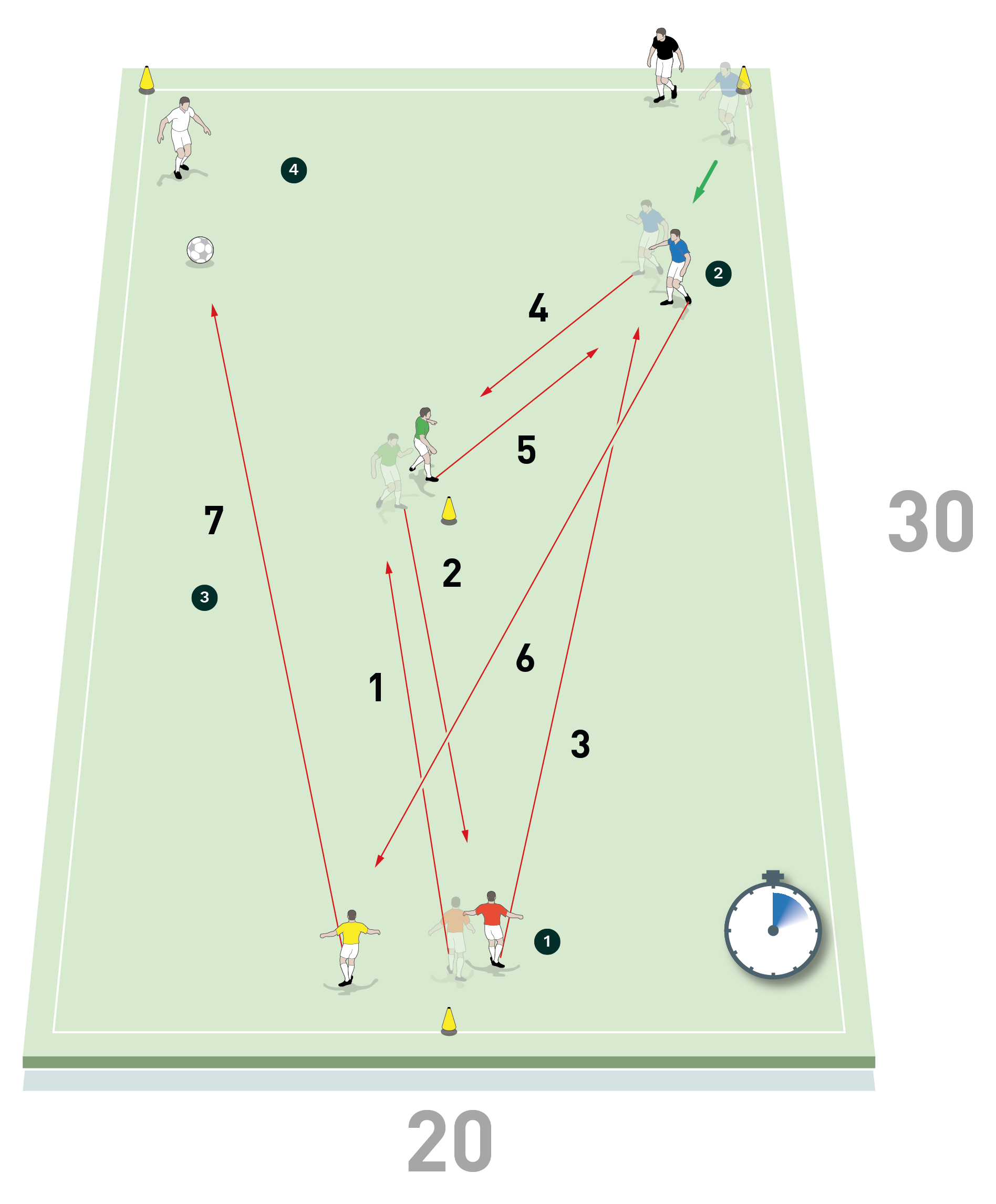
2. The blue plays a one-two with the green and then passes to the yellow
3. The yellow changes the point of attack by passing to the white
4. The white will pass the ball into the player on the central cone to end the sequence
[1c]

2. The green passes to the blue, who passes back to the red at the end of the red player’s overlapping run. After each action, the players follow their pass into the space in front
3. The red receives on the move and passes across to the yellow, who plays a one-two with the green and then dribbles back towards the black at the starting position
4. Play continues with the black making a new starting pass with a second ball
[1d]
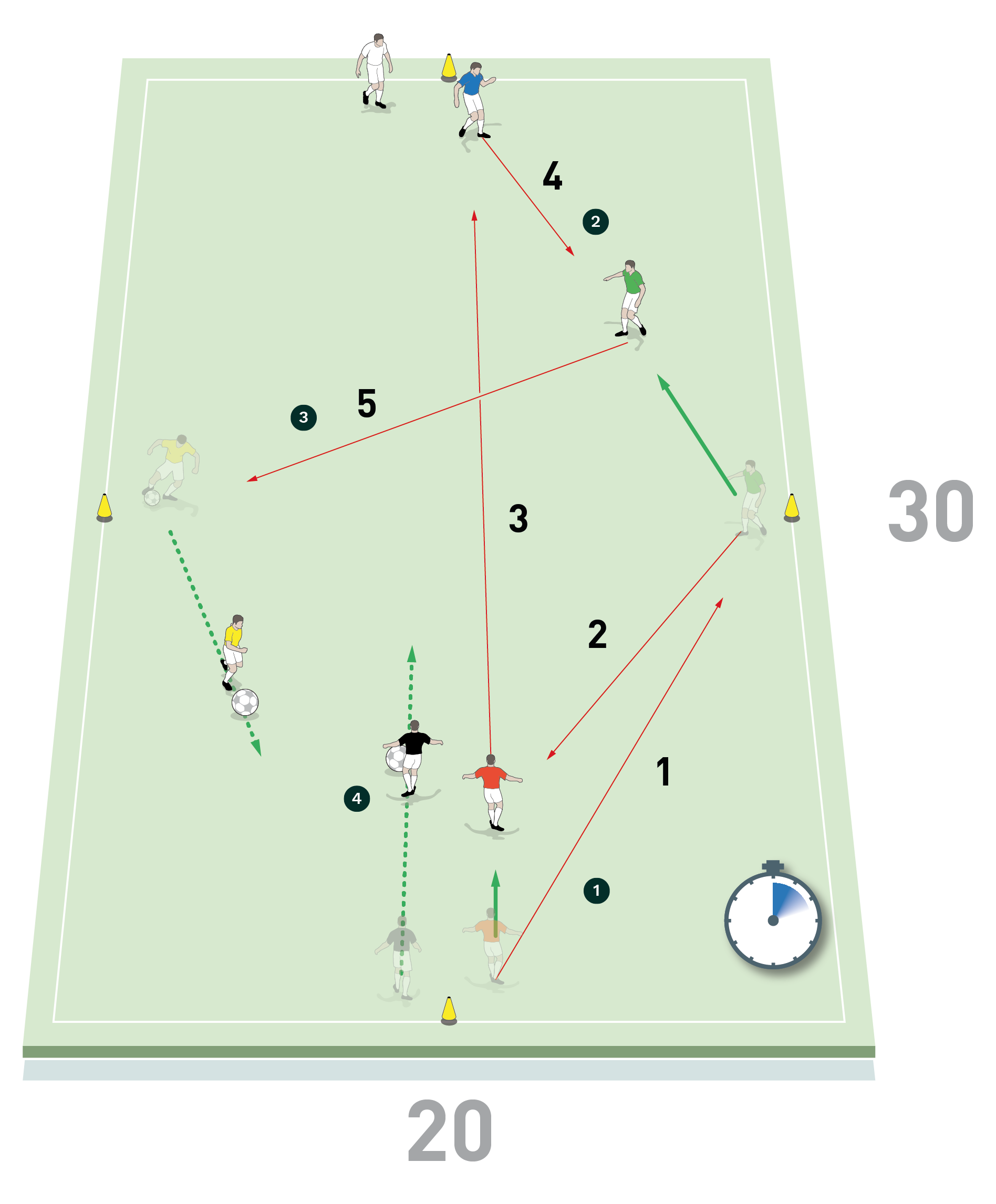
2. The blue passes to the green, who has moved forward to receive
3. The green passes to the yellow, who dribbles the ball towards the black
4. Next the black dribbles forwards with a new ball
“Technically, we want to see players demonstrating a good first touch and showing efficient control, finishing, turning, dribbling and receiving skills”
The blue plays a one-two with the green and then passes to the yellow, who changes the point of attack by passing to the white. The white plays the ball into the player on the central cone and the passing sequence begins again. After each action, players follow the pass to the next station.
For the third and fourth exercises the cones are repositioned. In the third exercise, as shown [1c], the red starts by passing to the green player and then makes an overlapping run outside. The green player passes to the blue, who passes back to red player at the end of the overlapping run. The red then plays across to yellow player, who plays a one-two with the green and then dribbles back towards the black at the starting position. The black begins the sequence again by making the starting pass with a new ball. After each action, the players follow their pass into the space in front of them.
In the fourth exercise, as shown [1d], the red starts by playing a one-two with the green and then passes to the blue player after moving off the cone. The blue passes to the green, who has moved forward to receive and passes to the yellow. The yellow player dribbles the ball towards the black, while the black begins a new sequence again by dribbling forwards with a second ball. After each action, the players follow their pass into the space in front of them.
We run each passing drill for three minutes with one minute’s rest in between.
FINISHING WAVES: 2v1 + GOALKEEPERS
[2]
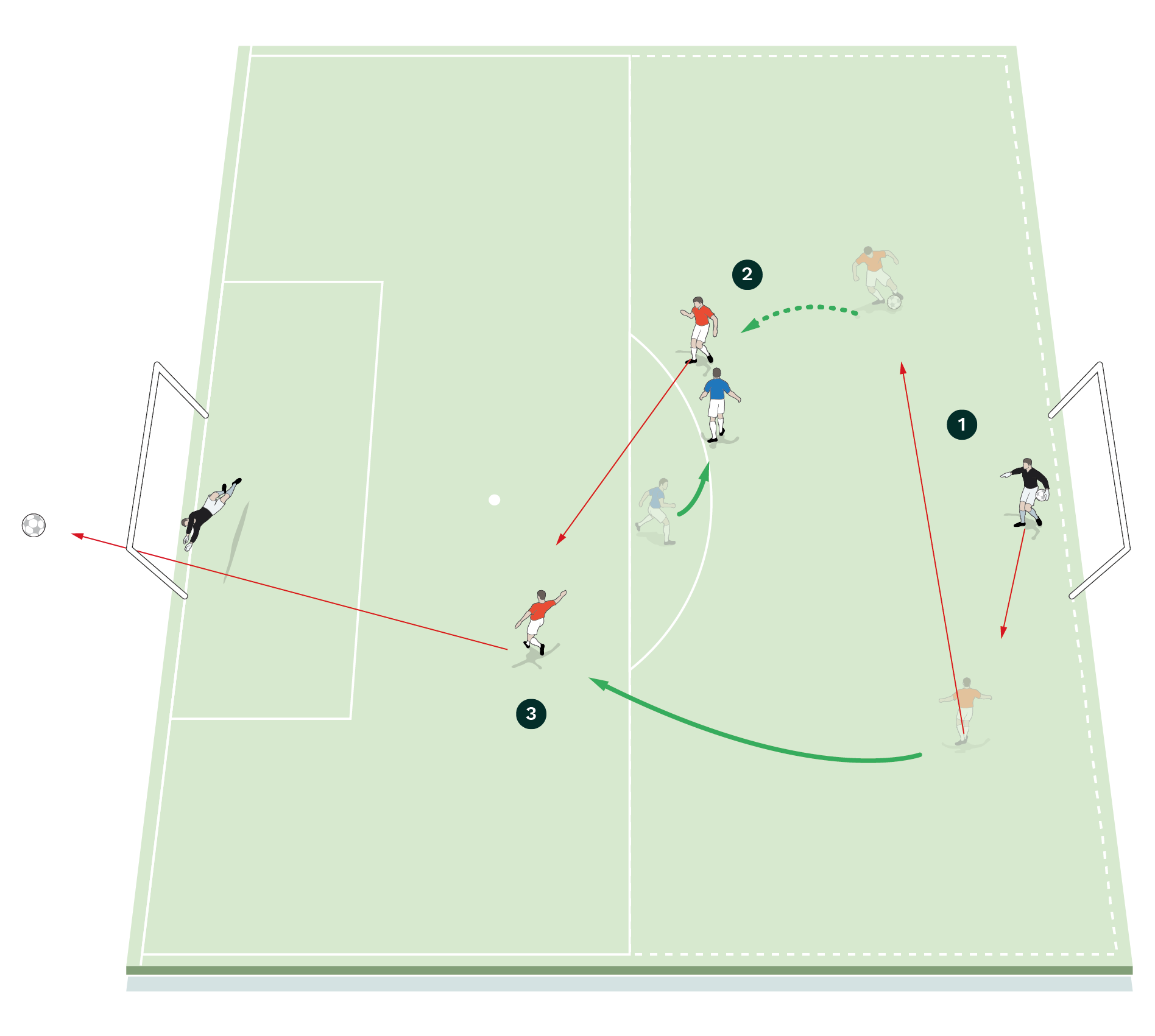
2. After receiving the ball, the second red takes it towards the blue player
3. To fix the blue player’s position, the second red changes speed and makes a cutting run to receive a return ball and finishes on goal
With this exercise we intend to approach the 2v1 situation in a dynamic manner. Focusing on the principle of offensive support, we also coach the offensive transition, leading the player who is defending to make a quick change of attitude and positioning from the defensive to the offensive. We also reinforce the importance of the ball carrier attacking space and the opponent and the second forward trying to get open either wide or by overlapping behind his team mate.
We set up a playing area as shown, with a goal and a goalkeeper at each end. We would use 10 outfield players divided into five teams of two, but it’s essentially a wave practice featuring different 2v1 combinations. In the diagram [2], we are showing two reds attacking one blue and trying to score in the goal, but when the ball goes dead the reds go to the end opposite to where they began and wait off the pitch while a second blue enters the pitch with a ball. The second blue joins his team mate in going 2v1 against a player from a third team who has entered the playing area from the opposite end.
FINISHING WAVES: 3v2 + GOALKEEPERS
Using the same attacking wave principles as the previous activity, we next run a 3v2 wave game using 15 outfield players divided into five teams of three, plus two keepers. This time, after the basic attack is complete, either through a shot on goal for the attacking team of three or a recovery of possession for the defending team of two, the third player joins his two team mates and quickly initiates the next action by trying to score against two new players from a third team who have entered the area to defend.
This exercise is identical to the previous one with respect to its dynamics but it is more complex because it involves more players. We keep the dynamics of 2v1 as a base principle of our style of play, as shown [3a], with the possibility of opening a second passing lane to the third player. This exercise notes the importance of the third forward to open the pitch through width, as shown [3b].
[3a]
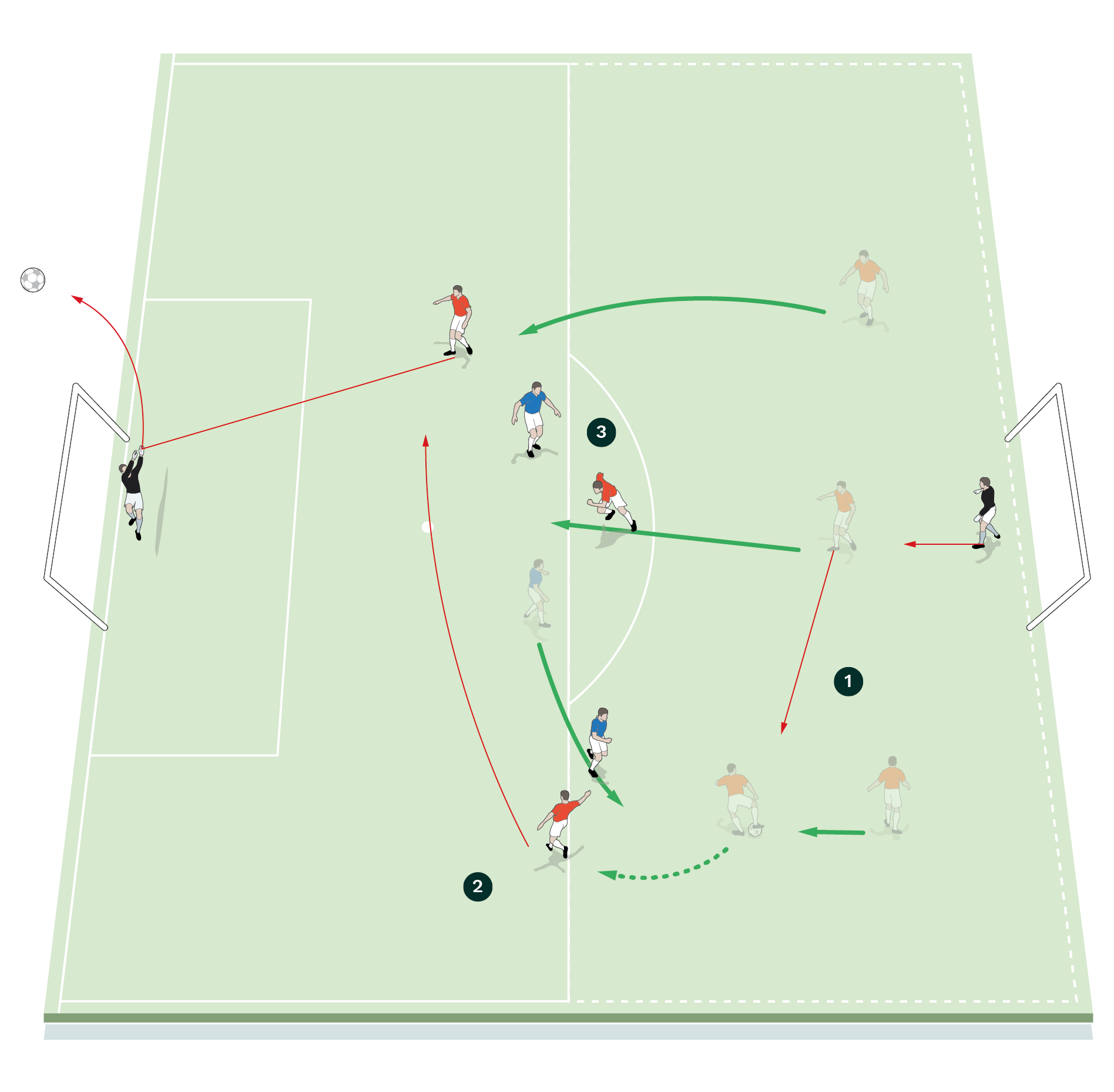
2. After receiving the ball, the second red player attacks the space or the closest opponent
3. To fix the defender’s position, the team mate who made the pass makes a run into space, leaving the player in possession with the option to dribble or pass
[3b]
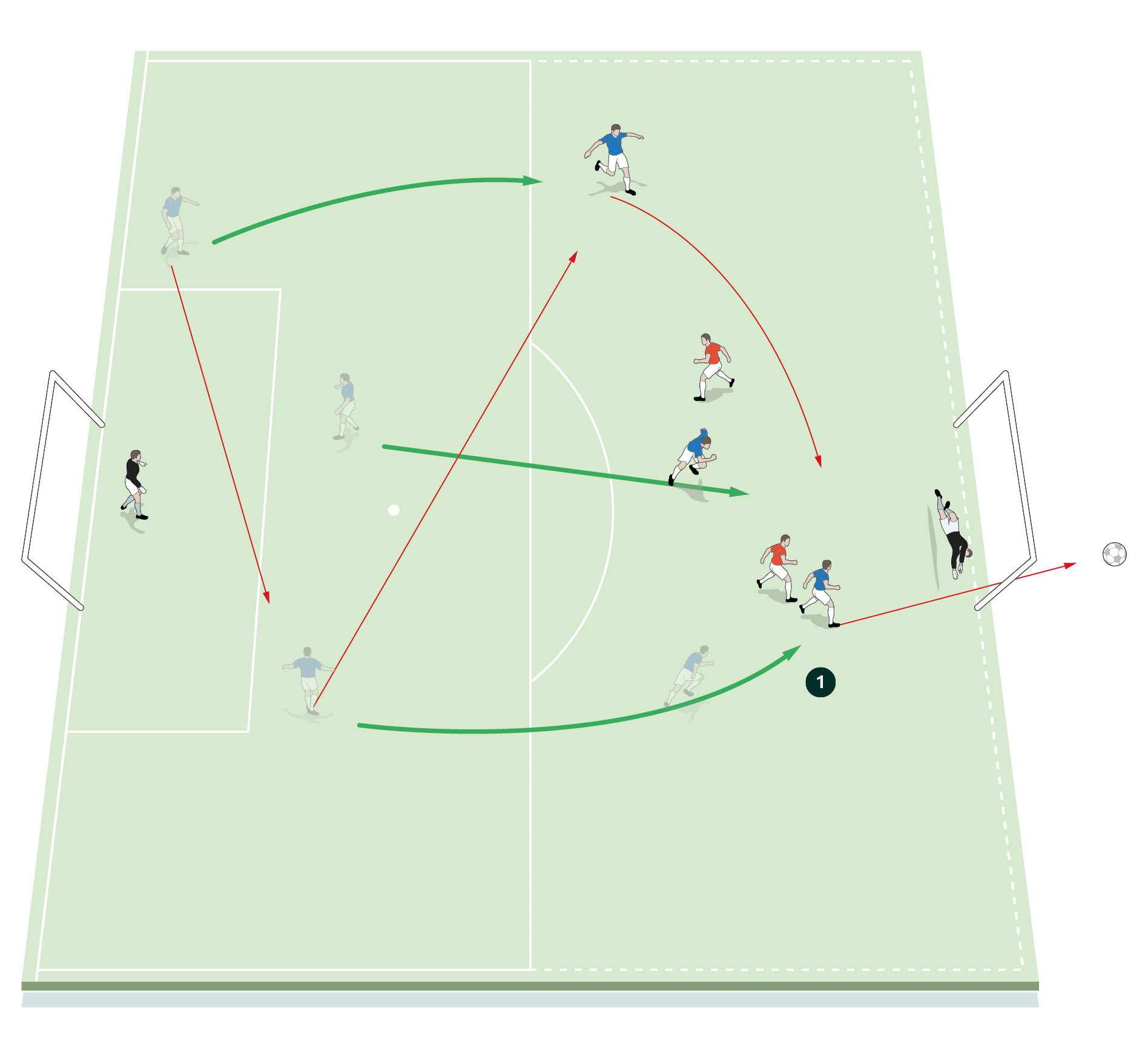
FINISHING WAVES: 4v3 + GOALKEEPERS
[4]
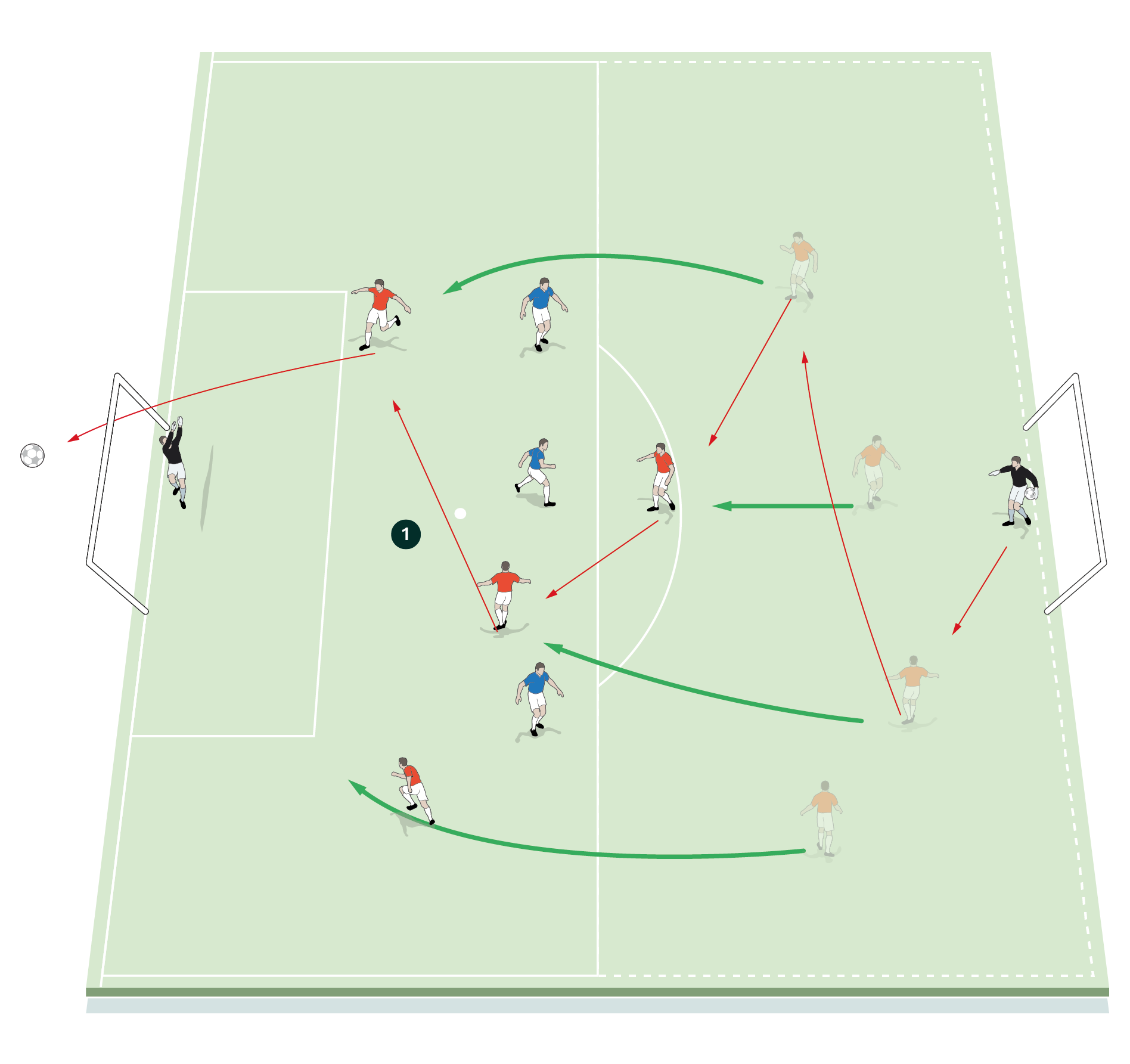
“The session has to be nice and sharp and lots of decisions have to be made from both the attacking and defending point of view”
Using the same attacking wave principles, we next run a 4v3 wave game using 20 outfield players divided into five teams of four, plus two keepers, as shown [4].
When receiving the ball from the keeper, the reds have an overload and a player comes up through the midfield and tries to create a goal scoring opportunity while facing the three opposition players. After the action is completed with a finish or by recovery of possession by the opposition team of three, the fourth player joins the defending team as they transition to attack. They use the first pass to play the ball to a team mate who runs through midfield and tries to score using their overload to get past the new opposition team of three.
4v3 RAPID ATTACKS
We change the size of the pitch, setting up between the penalty boxes with a goal and a goalkeeper at each end. We’re using 20 outfield players divided into five teams of four, plus two keepers, and we play 4v3 rapid attacks.
This exercise keeps the same wave dynamic as the previous activities but with increased complexity. Play starts with the goalkeeper who plays the ball to an attacker. The attacker’s first pass should be a quick ball out to the wing, while the players attack the space and exploit the overload, as shown [5]. Once the first pass has been received, the three opposition defenders move to try and cover the attack and win the ball. The three defending players cover the middle areas so it’s like a counter-attack with the attackers looking to find and exploit space on the pitch.
When the ball is dead or when the defending team of three win possession, a fourth member of the defending team should enter play and they quickly transition to attack, making the first pass out to the wing and using width to attack a new defending team of three who have entered play.
[5]

2. The attacker’s first pass should be a quick ball out to the wing
3. Once the first pass has been received, the three opposition defenders move to cover the attack in the middle areas of the pitch and try to win possession
4. The attackers look to use their overload to find and exploit space on the pitch
COACHING POINTS
How do I progress the session?
We always have to challenge the players more and more. We can do this by reducing the area size or limiting the numbers of touches players can take. We could also limit the amount of time players have to finish.
What are the key things to look for?
The session has to be nice and sharp, performed in a short space of time when lots of decisions have to be made from both the attacking and defending point of view.
Technically, we want to see players demonstrating a good first touch, and showing efficient control, finishing, turning, dribbling and receiving skills.
Tactically, we want to see players using overlapping runs and recognising the space to receive the ball. We also want to see players using good communication skills and the ability to block shots.
What are the typical mistakes players might make and how do I avoid them?
In transitions, the most common mistake is poor decision making.
Speaking technically, the most common mistake is using the wrong surface of the foot. Players can also play at the wrong tempo and lack intensity, with incorrect levels of aggression.
Related Files
Editor's Picks
Deep runs in the final third
Using the goalkeeper in build-up play
Pressing principles
Intensive boxes drill with goals
Penetrating the final third
Creating and finishing
My philosophy
Pressing initiation
Compact team movement
Coaches' Testimonials

Alan Pardew

Arsène Wenger

Brendan Rodgers

Carlos Carvalhal

José Mourinho

Jürgen Klopp

Pep Guardiola

Roy Hodgson

Sir Alex Ferguson

Steven Gerrard
Coaches' Testimonials

Gerald Kearney, Downtown Las Vegas Soccer Club

Paul Butler, Florida, USA

Rick Shields, Springboro, USA

Tony Green, Pierrefonds Titans, Quebec, Canada
Join the world's leading coaches and managers and discover for yourself one of the best kept secrets in coaching. No other training tool on the planet is written or read by the calibre of names you’ll find in Elite Soccer.
In a recent survey 92% of subscribers said Elite Soccer makes them more confident, 89% said it makes them a more effective coach and 91% said it makes them more inspired.
Get Monthly Inspiration
All the latest techniques and approaches
Since 2010 Elite Soccer has given subscribers exclusive insight into the training ground practices of the world’s best coaches. Published in partnership with the League Managers Association we have unparalleled access to the leading lights in the English leagues, as well as a host of international managers.
Elite Soccer exclusively features sessions written by the coaches themselves. There are no observed sessions and no sessions “in the style of”, just first-hand advice delivered direct to you from the coach.
